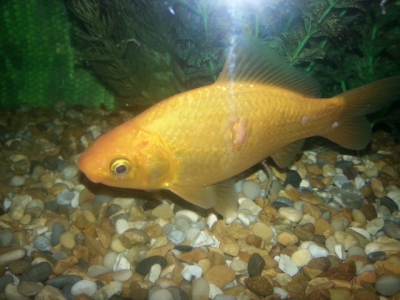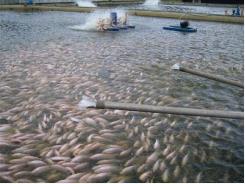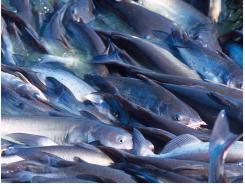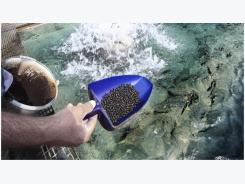The Role of Stress in Fish Disease

Stress
Physiological stress and physical injury are the primary contributing factors of fish disease and mortality in aquaculture. Stress is defined as physical or chemical factors that cause bodily reactions that may contribute to disease and death. Many potential fish disease pathogens are continually present in the water, soil, air, or fish. In nature fish are often resistant to these pathogens, and they are able to seek the best living conditions available. Food fish reared under commercial aquaculture conditions are confined to the production unit and are weakened by stress conditions including:
- Increased fish density and poor water quality (i.e., low dissolved oxygen, undesirable temperature or pH, Increased levels of carbon dioxide, ammonia, nitrite, hydrogen sulfide, organic matter in the water);
- Injury during handling (i.e., capture, sorting, shipping);
- Inadequate nutrition;
- And poor sanitation.
These conditions can result in decreased resistance by the fish, resulting in the spread of disease and parasite infestation. Stress and injury initially trigger an alarm reaction (fight or flight response), which results in a series of changes within the fish. A blood sugar increase occurs in response to hormone secretion from the adrenal gland as liver glycogen is metabolized. This produces a burst of energy which prepares the animal for an emergency situation. In addition, the inflammatory response, a defense used by fish against invading disease organisms, is suppressed by hormones released from the adrenal gland. Water balance in the fish (osmoregulation) is disrupted due to changes in the metabolism of minerals. Under these circumstances, freshwater fish absorb excessive amounts of water from the environment (over-hydrate); saltwater fish lose water to the environment (dehydrate), This disruption increases energy requirements for osmoregulation. Respiration increases, blood pressure increases, and reserve red blood cells are released into the blood stream.
Fish are able to adapt to stress for a period of time; they may look and act normal. However, energy reserves are eventually depleted and hormone imbalance occurs, suppressing their immune system and increasing their susceptibility to infectious diseases.
Defense Against Infection
Mucus
Mucus (slime layer) is the first physical barrier that inhibits entry of disease organisms from the environment into the fish. It is also a chemical barrier, containing enzymes and antibodies which can kill invading disease organisms. Mucus also lubricates the fish, aiding their movement through water, and is important for osmoregulation.
Injury as a result of handling (i.e., capture, transport, etc.) and certain chemicals in the water (i.e., poor water quality, disease treatments) remove or damage the mucous layer, reducing its effectiveness as a barrier against infection at a time when it is needed most. This damage decreases the chemical protection of the slime layer and also results in excessive uptake of water by freshwater fish and dehydration by saltwater fish. Decreased lubrication causes the fish to expend more energy to swim at a time when its energy reserves are already depleted.
Scales and skin
Scales and skin function as a physical barrier which protects the fish. These are injured most commonly by handling, rough surfaces of tanks or cages, and by fighting caused by overcrowding or reproductive behavior. Parasite infestations can also result in damage to gills, skin, fins, and loss of scales. Damage to scales and skin of the fish can increase the susceptibility to infection. It also causes excessive uptake of water by freshwater fish or loss of water from marine species (osmotic stress). Fish which are heavily parasitized may die from bacterial infections which gained initial entrance to the fish's body through damaged areas in the skin.
Inflammation
Inflammation is a natural immune response by the cells to a foreign protein, such as bacterium, virus, parasite, fungus, or toxin. Inflammation is characterized by swelling, redness, and loss of function. It is a protective response, an attempt by the body to wall off and destroy the invader.
Any stress causes hormonal changes which decrease the effectiveness of the inflammatory response. Temperature stress, particularly cold temperatures, can completely halt the activity of the immune system, eliminating this defense against invading disease organisms. Excessively high temperatures are also extremely detrimental to the fish's ability to withstand infections. High water temperature may favor rapid population growth of some pathogens. High temperature also reduces the ability of the water to hold oxygen and increases the metabolic rate and resulting oxygen demand of the fish.
Antibodies
Unlike inflammation and other nonspecific forms of protection, antibodies are compounds formed by the body to fight specific foreign proteins or organisms. The first exposure results in the formation of antibodies by the fish which will help protect it from future infection by the same organism. Exposure to sublethal concentrations of pathogens is important for fish to develop a competent immune system. Animals raised in a sterile environment will have little protection from disease. Young animals may not have as effective an immune response as older animals and therefore, may be more susceptible to pathogens in the environment.
Stress impairs the production and release of antibodies. Temperature stress, particularly rapid changes in temperature, severely limits the fish's ability to release antibodies, giving the invader time to reproduce and overwhelm the fish. Prolonged stress reduces the effectiveness of the immune system, increasing the opportunities for disease-causing organisms.
Disease Prevention
Numerous books and articles have been written on the diagnosis and treatment of specific fish diseases; however, prevention through good management practices is the best control measure to minimize disease problems and fish kills. Good management involves maintaining good water quality, preventing injury and stress during handling providing good nutrition, and using sanitation procedures, The following are management practices that help prevent stress and the resulting fish kills.
Water quality
- Do not exceed carrying capacity of fish in ponds and tanks.
- Monitor water quality parameters.
- Maintain dissolved oxygen levels above 5 mg/L. Sub-optimum levels of dissolved oxygen, while not immediately lethal, may stress fish, resulting in delayed mortality.
- Prevent the accumulation of organic debris, nitrogenous wastes (ammonia and nitrite), carbon dioxide, and hydrogen sulfide.
- Maintain appropriate pH, alkalinity, and temperature for the species.
Handling and transporting
- Use capture methods that minimize physical injury and stress.
- When possible, use knitted mesh nets rather than knotted nets to reduce injury and scale loss.
- Speed and gentleness when handling fish are of utmost importance.
- Minimize the number of times the fish are lifted from the water, and work as quickly as possible when transferring fish.
- Harvest, handle, and transport fish at times when fish are least susceptible to stress and infection.
- Transport and holding tanks should be large enough to allow complete freedom of movement of fish and have no sharp corners or edges that might injure the fish.
- Maintain optimum water conditions while capturing, hauling, and handling fish.
- A high level of dissolved oxygen is crucial for rapid recovery of the fish from the struggle of capture and handling.
- Salt (0.3 to 1.0 percent) maybe used in the transport water to minimize osmotic stress and bacterial infection of freshwater fish.
- Ice may be added to the water during hauling to prevent an increase in water temperature which reduces the ability of the water to hold oxygen and increases the metabolic rate and resulting oxygen demand of the fish.
Nutrition
- Feed a high quality diet that meets the nutritional requirements of the species.
- Use proper feeding rate (either over-feeding or starving the fish should be avoided).
- Store feed in a cool dry place to prevent deterioration. If avail able, a freezer is ideal for storing fish feed.
Sanitation
- Quarantine all new fish and observe for mortality. Send samples to a diagnostic laboratory to be examined for parasites and evaluated for viral and bacterial disease.
- Prevent disease-carrying fish from living in hatchery water supply (e.g., reservoir ponds, springs, streams).
- Remove all dead fish from a production system as soon as they are observed.
- Dispose of dead fish properly to prevent the spread of disease.
- Use good sanitation practices resulting in clean equipment, ponds, and tanks. Disinfect containers, nets, and equipment to minimize transmission of parasites and disease from one population to another.
Conclusions
Stress compromises the fish's natural defenses against invading pathogens. When disease outbreaks occur, the underlying stress factors, as well as the disease organism, should be identified. Correcting stress factors should precede or accompany chemical disease treatments. A disease treatment is only an artificial way of slowing down an infection so that the fish's immune system has time to respond. Any stress which adversely affects the fish will result in an ongoing disease problem. Prevention of disease outbreaks is more cost-effective than treating dying fish.
Related news
Tools

Phối trộn thức ăn chăn nuôi

Pha dung dịch thủy canh

Định mức cho tôm ăn

Phối trộn phân bón NPK

Xác định tỷ lệ tôm sống

Chuyển đổi đơn vị phân bón

Xác định công suất sục khí

Chuyển đổi đơn vị tôm

Tính diện tích nhà kính

Tính thể tích ao



 Walleye and saugeye growing successfully indoors
Walleye and saugeye growing successfully indoors  Research team makes breakthrough toward fish-free aquaculture feed
Research team makes breakthrough toward fish-free aquaculture feed